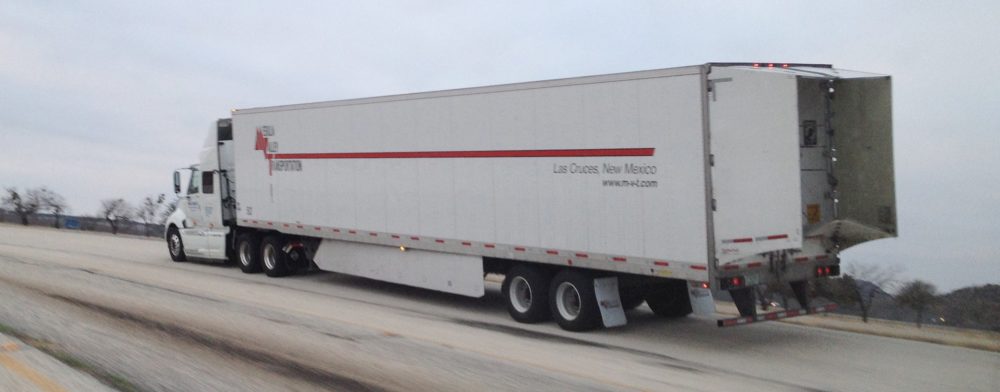As you find yourself traveling on the road these holidays, you may notice something different about tractor-trailers—some of them are wearing skirts. Because of the roughly 100,000 miles traveled annually by the average long haul tractor-trailer (ie semi-truck, or big rig), putting on one of these long skirts (pictured below) is like eliminating the global warming pollution from an average car. Here’s how, and why we need more of them.
Boxy trailers burn more fuel
While big, boxy van trailers can make for efficient logistics to pack in as much material in as quick a time as possible at the warehouse, they are not very aerodynamic. The tractors pulling these trailers have received aerodynamic nose jobs over the years to cut down on drag at the front of the vehicle, but the trailers being pulled have largely been ignored.
Pockets of turbulence can develop behind and under these trailers, increasing drag and the amount of energy needed to pull them. A trailer skirt is a device that can improve efficiency of the tractor-trailer by 5% just by smoothing out that drag under the trailer and pushing the air around the trailer wheels. Boat-tails at the back can add additional fuel savings by reducing turbulence in the wake of air behind the vehicle. There are even undertrays and rear fairings out there helping to direct air flow, pulling from some of the same design concepts as Formula One race cars!

Tractor-trailer with undertray (in blue) and end fairings (in white), modeled after F-1 race car design principles
Why we are seeing them now
Federal investments in improving tractor-trailers have helped to spur a number of companies to develop these new trailer technologies, but the biggest push to market has come from California. The California Air Resources Board requires that any long haul box trailer operating in the state must have both aerodynamic devices and tires that can help reduce rolling resistance, as verified by the EPA’s SmartWay program. The program in California has worked so well to bring prices down for these technologies that major trailer manufacturers are seeing sales of these devices improve not just in California, but nationwide. Fleet operators around the country are recognizing real fuel savings and reducing their environmental footprint at the same time.
“More” is good, but “better” can save millions
While these technologies are making in-roads, they are not yet ubiquitous, and an additional push from the federal government can help move the devices available today from the shelf to the street, saving fuel for truck drivers and reducing global warming emissions for us all. It can also help further investment in these technologies, so we can continue to develop newer and better ways to reduce oil consumption and global warming pollution from the tractor-trailer fleet.
By combining improvements to the trailer with those available to the tractor, we have the opportunity to improve the efficiency of a long haul tractor-trailer by nearly 50% compared to 2010, which would save over 250 million barrels of oil a year from the long haul fleet and over 300 billion tons of global warming emissions annually by 2030. This is why a second phase of heavy-duty vehicle regulations is called for in the President’s Climate Action Plan and why these vehicles are a key part of our Half the Oil plan.
Honk for progress
Next time you see a trailer on the freeway with these devices, know that not only is it helping to save that trucker money with improved fuel economy—it is helping to reduce oil usage and global warming emissions for us all. So honk for the trucks and truckers that are helping to lower impacts from this cornerstone of our economy—tell ‘em to flaunt that skirt.

